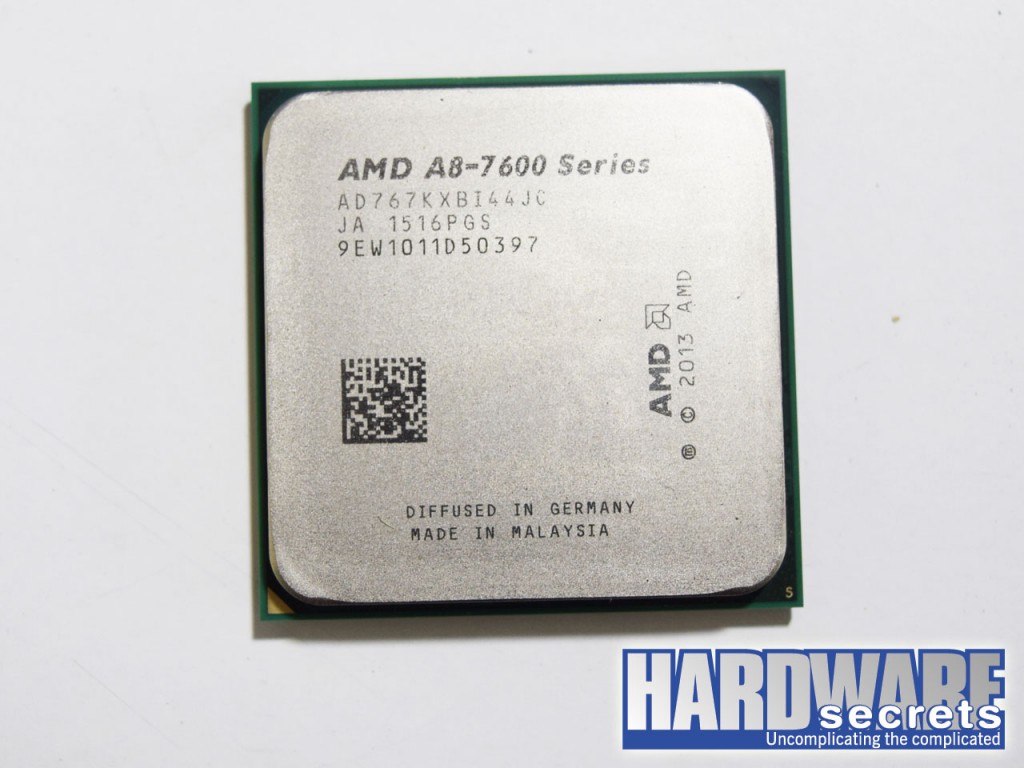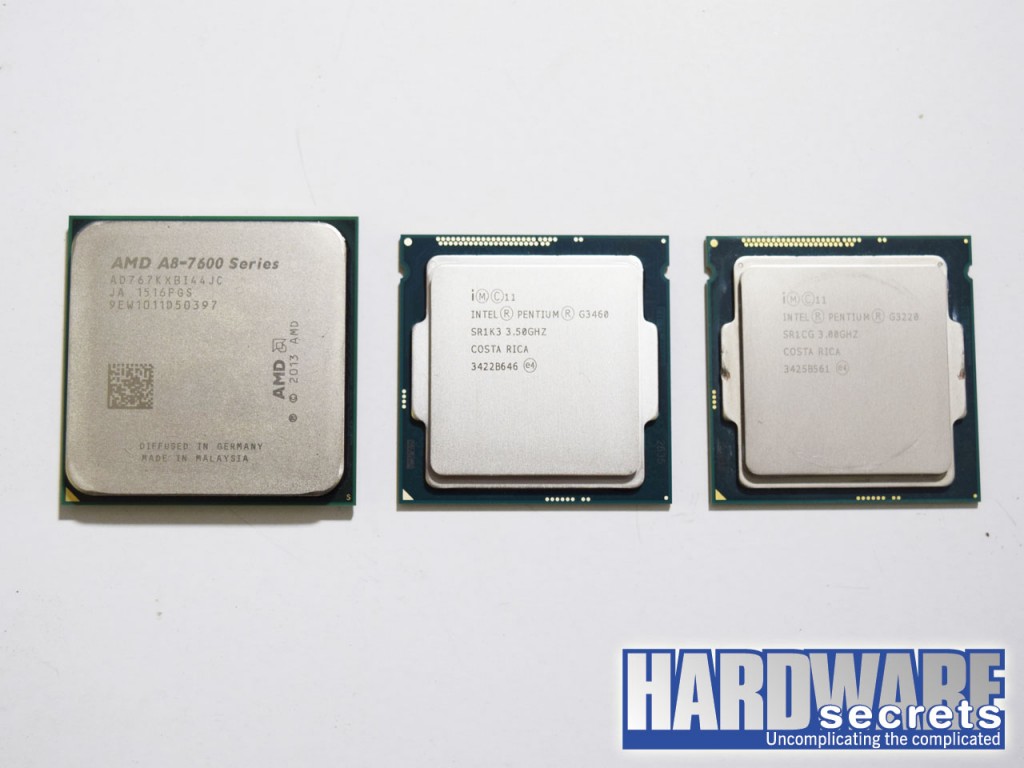[nextpage title=”Introduction”]
AMD recently launched their new APUs (as they call the CPUs with integrated video), codenamed “Godavari”, which brings some minor upgrades over the “Kaveri” models. One of those new models is the A8-7670K, which is a mainstream quad-core CPU with an integrated Radeon R7 GPU. Let’s see how it performs compared to one of its direct competitors, the Pentium G3460.
The A8-7670K is, based on its characteristics, similar to the A10-7800, which we already tested. Actually, the A8-7670K has a slightly higher base clock (3.6 GHz against 3.5 GHz of the A10-7800). The main difference is on the GPU: while the newer A10 processors bring a GPU with 512 cores in eight computing units, the GPU present on the A8-7670K has 384 cores in six computing units.
Figure 1 reveals the A8-7670K processor we used in our tests.
 Figure 1: the A8-7670K processor
Figure 1: the A8-7670K processor
We compared the performance of the A8-7670K to one of its direct competitors, the Pentium G3460. We also included in the comparison a Pentium G3220, which we already tested.
Notice that, despite the fact the Pentium G3460 is a dual-core CPU and the A8-7670K is a quad-core one, we consider they are direct competitors because they have similar price tags.
 Figure 2: the A8-7670K (left), the Pentium G3460 (center), and the Pentium G3220 (right)
Figure 2: the A8-7670K (left), the Pentium G3460 (center), and the Pentium G3220 (right)
Let’s compare the main specs of the reviewed CPUs in the next page.
[nextpage title=”The Reviewed CPUs”]
In the tables below, we compare the main features of the CPUs included in our review.
| CPU | Cores | HT | IGP | Internal Clock | Turbo Clock | Core | Tech. | TDP | Socket | Price |
| A8-7670K | 4 | No | Yes | 3.6 GHz | 3.9 GHz | Godavari | 28 nm | 95 W | FM2+ | USD 95 |
| Pentium G3460 | 2 | No | Yes | 3.5 GHz | No | Haswell | 22 nm | 53 W | LGA1150 | USD 90 |
| Pentium G3220 | 2 | No | Yes | 3.0 GHz | No | Haswell | 22 nm | 53 W | LGA1150 | USD 66 |
Below you can see the memory configuration for each CPU.
| CPU | L2 Cache | L3 Cache | Memory Support | Memory Channels |
| A8-7670K | 2 x 2 MiB | No | Up to DDR3-2133 | Two |
| Pentium G3460 | 2 x 256 kiB | 3 MiB | Up to DDR3-1600 | Two |
| Pentium G3220 | 2 x 256 kiB | 3 MiB | Up to DDR3-1333 | Two |
Below we have a comparison of the graphic engine of each CPU.
| CPU | GPU | DirectX | Clock | Cores |
| A8-7670K | Radeon R7 | 12 | 757 MHz | 384 |
| Pentium G3460 | Intel HD | 11.1 | 350/1100 MHz | 10 |
| Pentium G3220 | Intel HD | 11.1 | 350/1100 MHz | 10 |
[nextpage title=”How We Tested”]
During our benchmarking sessions, we used the configuration listed below. Between our benchmarking sessions, the only variable device was the CPU being tested and the motherboard, which had to be replaced to match the different CPUs.
Hardware Configuration
- Motherboard (socket LGA1150): ASRock Z97 Extreme4
- Motherboard (socket FM2+): ASRock FM2A88X Extreme6+
- CPU Cooler: Intel/AMD stock
- Memory: 8 GiB DDR3-2133, two G.Skill Ripjaws F3-17000CL9Q-16GBZH 4 GiB memory modules configured at the maximum speed of each CPU (1,333 MHz, 1,600 MHz, or 2,133 MHz)
- Boot drive: Kingston HyperX Savage 480 GB
- Video Card: integrated
- Video Monitor: Philips 236VL
- Power Supply: Corsair CX500M
Operating System Configuration
- Windows 7 Home Premium 64-bit
- NTFS
- Video resolution: 1920 x 1080 60 Hz (desktop ), 1280 x 720 (games)
Driver Versions
- AMD driver version: 15.7
- Intel Inf chipset driver version: 10.0
Software Used
- 3DMark 1.5.915
- Adobe Photoshop CC + Retouch Artist Speed Test 1.0
- Cinebench R15
- DivX 10.2.4
- DVD Shrink 3.2
- Media Espresso 6.7
- PCMark 8 2.4.304
- Battlefield 4
- Life is Strange
- Bioshock Infinite
Error Margin
We adopted a 4% error margin. Thus, differences below 4% cannot be considered relevant. In other words, products with a performance difference below 4% should be considered as having similar performance.
[nextpage title=”PCMark 8″]
PCMark 8 is a benchmarking software that uses real-world applications to measure the computer performance. We ran three tests: Home, which includes web browsing, writing, light gaming, photo editing, and video chat tests; Creative, that includes web surfing, video editing, group video chat, video conversion, and gaming; and Work, which runs tasks such as writing documents, web browsing, spreadsheets, editing, and video chatting. Let’s see the results.

On the Home test, the A8-7670K obtained a performance result similar to the Pentium G3450 and to the Pentium G3220.
On the Work test, the A8-7670K was 16% slower than the Pentium G3460, and 9.8% slower than the Pentium G3220.
[nextpage title=”3DMark”]
3DMark is a program with a set of several 3D benchmarks. Sky Diver measures DirectX 11 performance, and is aimed on average computers. The Cloud Gate benchmark measures DirectX 10 performance, and the Ice Storm Extreme measures DirectX 9 performance and is targeted to entry-level computers.
On the Sky Diver benchmark, the GPU present in the A8-7670K was 386% faster than the Pentium G3460’s, and 404% faster than the Pentium G3220’s.
On the Cloud Gate benchmark, the A8-7670K’s GPU was 172% faster than the Pentium G3460’s, and 185% faster than the Pentium G3220’s.
On the Ice Storm Extreme benchmark, the graphics engine of the A8-7670K was 154% faster than the Pentium G3460’s, and 172% faster than the Pentium G3220’s.
[nextpage title=”Photoshop CC and Cinebench R15″]
Photoshop CC
The best way to measure the performance of a CPU is by using real programs. The problem, of course, is to create a methodology that offers precise results. For Photoshop CC we used a script named “Retouch Artist Speed Test”, which applies a series of filters to a standard image and gives the time Photoshop takes to run all of them. The results are given in seconds, so the less, the best.

In this test, the A8-7670K was 33% slower than the Pentium G3460 and 26% slower than the Pentium G3220.
Cinebench R15
Cinebench R15 is based on the Cinema 4D software. It is very useful to measure the performance gain obtained by the presence of several processing cores while rendering heavy 3D images. Rendering is an area where a bigger number of cores helps a lot, because usually this kind of software recognize several processors (Cinebench R15, for example, can use up to 256 processing cores).
We ran the CPU benchmark, which renders a complex image using all the processing cores (real and virtual) to speed up the process. The result is given as a score.

Here the A8-7670K was 15% faster than the Pentium G3460 and 33% faster than the Pentium G3220.
[nextpage title=”Video encoding”]
DivX
We used the DivX converter, a tool included in the DivX package, in order to measure the encoding performance using this codec. The DivX codec is capable of recognizing and using all available cores and the SSE4 instruction set.
We converted a Full HD, six-minute long .mov video file into a .avi file, using the “HD 1080p” output profile. The results below are given in seconds, so the lower the better.
On DivX encoding, the A8-7670K was 17% slower than the Pentium G3460, but was on par with the Pentium G3220.
DVDShrink
DVDShrink is an old but still very useful program to “shrink” video DVDs that have more than 4.7 GiB of data to fit single-layer DVD media. We used it to compress the DVD of “The Lord of the Rings: The Fellowship of the Ring” DVD to 4.7 GiB. The results below are given in seconds, so the lower the better.

In this test, the A8-7670K was 22% faster than the Pentium G3460 and 32% faster than the Pentium G3220.
Media Espresso
Media Espresso is a video conversion program that uses the graphics processing unit of the video engine to speed up the conversion process. We converted a 1 GiB, 1920x1080i, 23,738 kbps, .mov video file to a smaller 320×200, H.264, .MP4 file for viewing on a smartphone. The results below are given in seconds, so the lower the better.
Here the A8-7670K was 30% slower than the Pentium G3460 and 19% slower than the Pentium G3220.
[nextpage title=”Gaming Performance”]
Battlefield 4
Battlefield 4 is the latest installment in the Battlefield franchise, released in 2013. It is based on the Frostbite 3 engine, which is DirectX 11. In order to measure performance using this game, we walked our way through the first mission, measuring the number of frames per second three times using FRAPS. We ran this game at 1280 x 720, setting overall image quality at “low.”
The results below are expressed in frames per second (fps) and they are the mean between the three collected results.

In Battlefield 4, the A8-7670K was 294% faster than the Pentium G3460 and 407% faster than the Pentium G3220.
Bioshock Infinite
Bioshock Infinite is an acclaimed first-person shooter with RPG released in 2013, using the Unreal Engine 3. We tested the performance in this game at its first scene, with the quality options as “ultra low” and resolution of 1280 x 720, measuring three times the framerate using FRAPS.
The results below are expressed in frames per second (fps) and they are the mean between the three collected results.

In this game, the performance of the A8-7670K was 329% higher than the other two tested CPUs.
Life is Strange
Life is Strange is a choice-based drama adventure game released in 2015, using the Unreal Engine 3. We tested the performance in this game playing the first scene with the quality options set as “low” and 1280 x 720 resolution, measuring the number of frames per second three times using FRAPS.
The results below are expressed in frames per second (fps) and they are the mean between the three collected results.

In Life is Strange, the A8-7670K was 310% faster than the Pentium G3460. The difference to the Pentium G3220 was similar.
[nextpage title=”Conclusions”]
The launch of the A8-7670K is a little frustrating, because AMD did not launch a CPU based on a new architecture for a long time. On the other hand, the manufacturer seems to be improving their current products, not only on the integrated GPU, but also on thermal management.
Comparing the A8-7670K from AMD to the Pentium G3460 from Intel, which has the same price, each one has its strong and weak points. It is clear that, on programs that take advantage of the biggest amount of processing cores, the A8-7670K is faster, while the Pentium G3460 is better in applications that do not use all the available cores.
About the integrated GPU, the superiority of the A8-7670K is clear, being several times faster than the Pentium G3460. While the Intel model simply cannot run even less demanding games, the A8-7670K allows the casual gamer to run even newer titles, obviously in lower quality options or resolution.
According to AMD, one of the factors that allow the high GPU performance is the support to 2,133 MHz memory.
Concluding, the A8-7670K processor is an excellent option if you are building a low budget computer, for multimedia applications or even casual gaming, if you do not intend to use an independent video card.








Leave a Reply